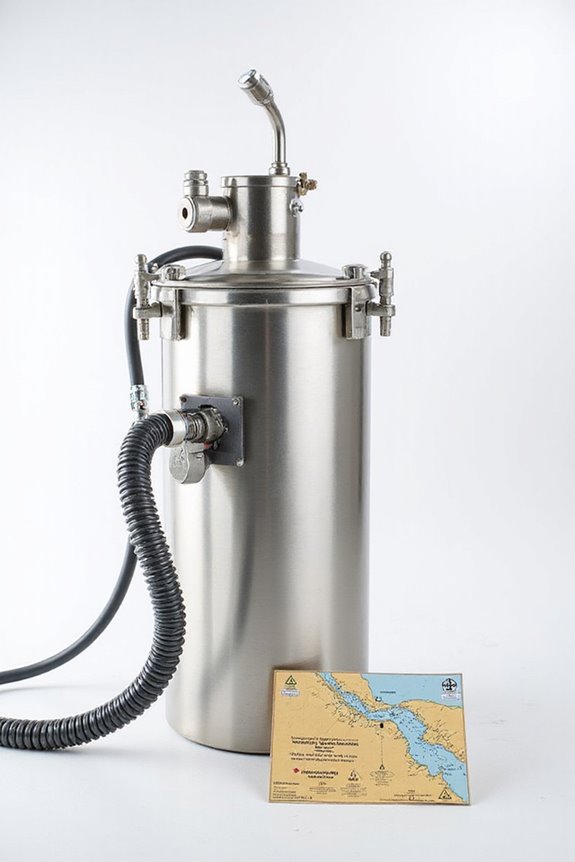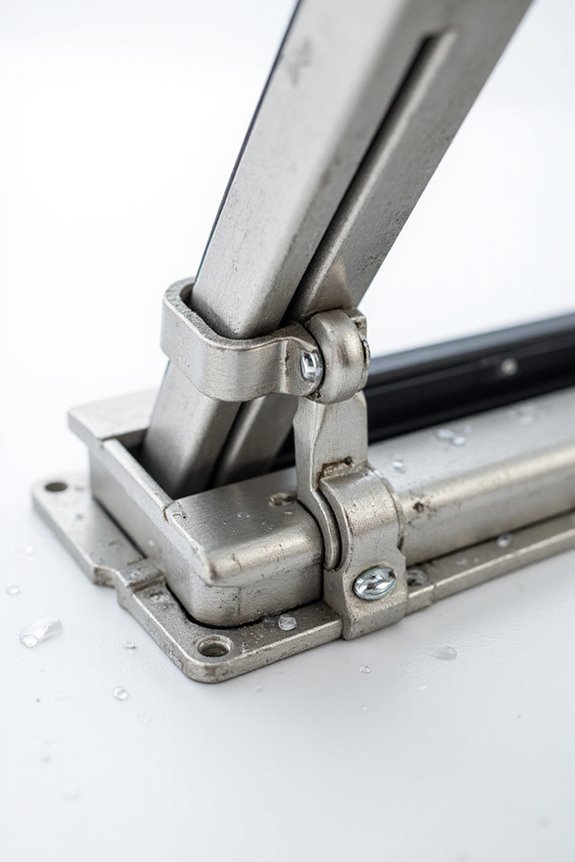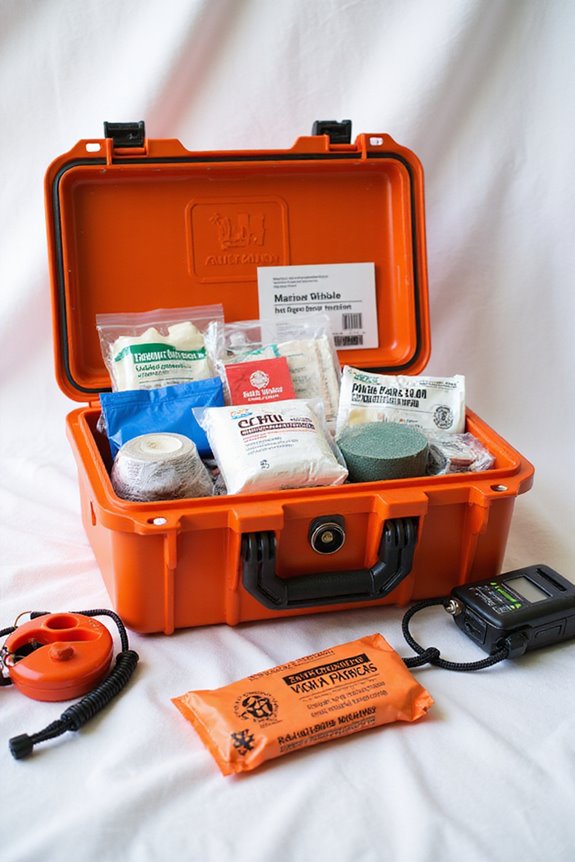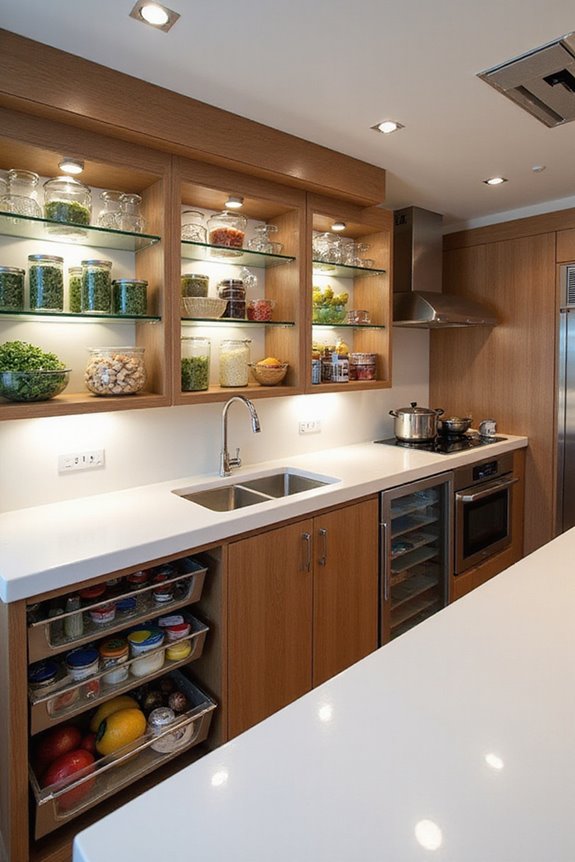Finding boat pump-out stations is easier than you might think, and it’s essential for keeping our waterways clean and wildlife happy. These stations safely handle waste from marine sanitation devices—think of them as the marinas’ secret weapon against water pollution. Thanks to apps and clear signage, we can locate nearby pump-outs fast, avoiding messy surprises. Plus, many marinas offer them free or affordably, supported by community grants. Ready to explore how funding, laws, and tech team up for cleaner waters?
Key Takeaways
- Use mobile apps like Pumpout Nav to easily find nearby boat pump-out stations with operational details and real-time status.
- Fixed point and slip side pump-out systems are commonly located near fueling piers and marina slips for convenient waste disposal.
- Look for visible signage from the water to identify legally required pump-out facilities in No Discharge Zones and sensitive waters.
- Many marinas provide pump-out services free or at regulated fees, supported by federal grants under the Clean Vessel Act.
- Regularly using pump-out stations helps maintain water quality and supports compliance with environmental regulations for boaters.
Purpose and Importance of Boat Pump-Out Stations
While we’re out enjoying the open water, it’s easy to forget the less glamorous side of boating—disposing of waste properly. That’s where pump out education and user awareness come in, helping us all do our part in protecting aquatic life and keeping waterways clean. Pump-out stations aren’t just convenient—they’re essential for following regulations and preventing pollution that can cause harmful algal blooms. Ever wonder why those nice clear marinas stay that way? It’s because boaters like us regularly use these facilities to safely empty holding tanks, preserving water quality for everyone’s enjoyment. Staying educated about proper use makes a real difference, avoiding spills or system issues. So next time you set sail, remember—good pump out habits aren’t just smart, they’re part of being a responsible member of our boating community.
Different Types of Waste Disposal Facilities for Boaters
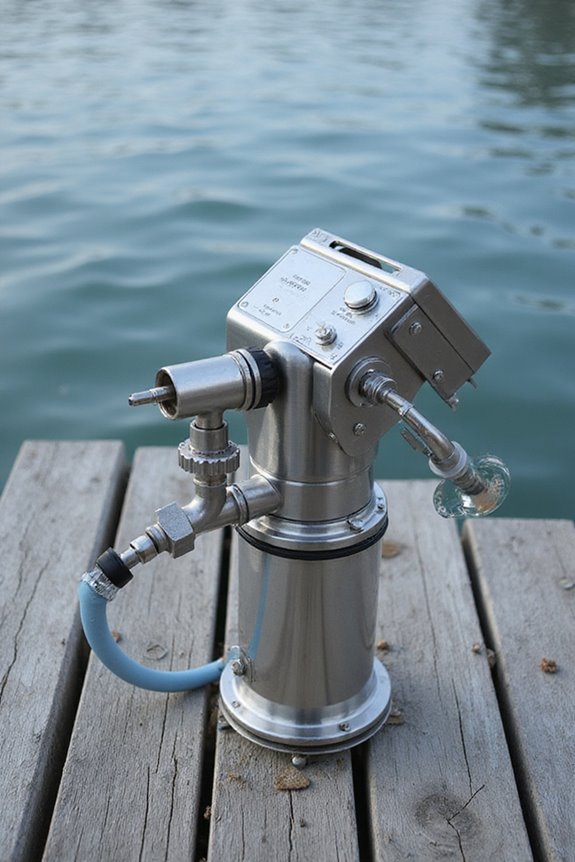
Because not all boats and marinas are alike, the ways we dispose of waste on the water vary quite a bit. We have fixed point systems—those permanent stations usually close to fueling piers where boats come for pump-outs. Then, there are portable units, which are perfect for smaller marinas; these mobile systems come to you, operated by pros with tanks to collect waste. For live-aboards, slip side systems let you pump out directly from individual slips—pretty convenient, right? Don’t forget dump stations, great for emptying portable toilets near launch ramps. And of course, the different MSD types (Marine Sanitation Devices) handle waste treatment differently, from basic holding tanks to tricked-out biological processors. Knowing these options helps us protect our waterways while keeping marina life flowing smoothly.
Legal Requirements for Providing Pump-Out Services
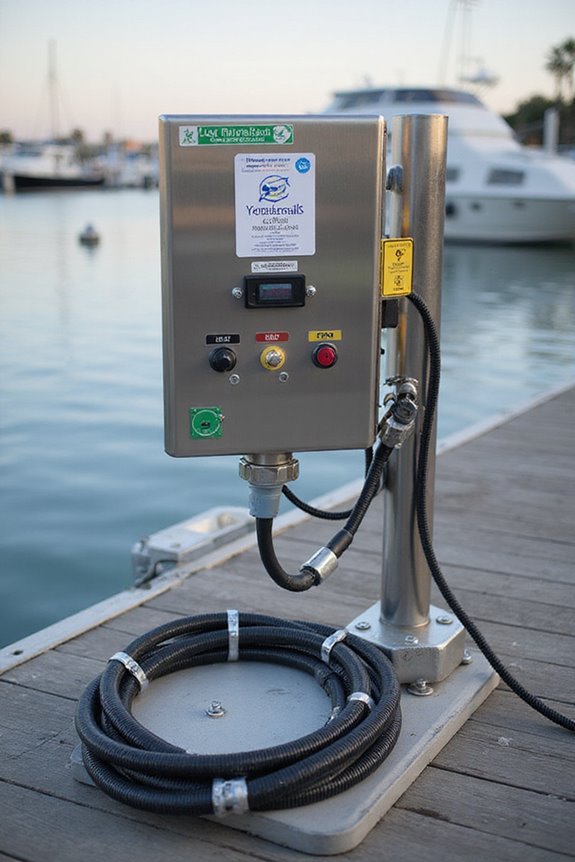
Since we’re all keen on keeping our waterways clean and enjoyable, you might wonder what laws actually require marinas to offer pump-out services—and why those rules matter. Well, legal compliance isn’t just a suggestion here; it’s a serious marina responsibility. For example, marinas with long docks usually must have operational pump-out stations accessible during normal hours, ensuring boaters can properly dispose of sewage. States, especially those with No Discharge Zones, mandate these facilities to protect sensitive waters. Plus, signage must be visible from the water—no guessing games allowed! There are even limits on fees, so marinas can’t charge an arm and a leg. So, if you ever worry about where to empty your marine sanitation device, rest assured these legal frameworks have your back and our waterways’ health in mind.
Funding Sources and Community Support for Pump-Out Stations
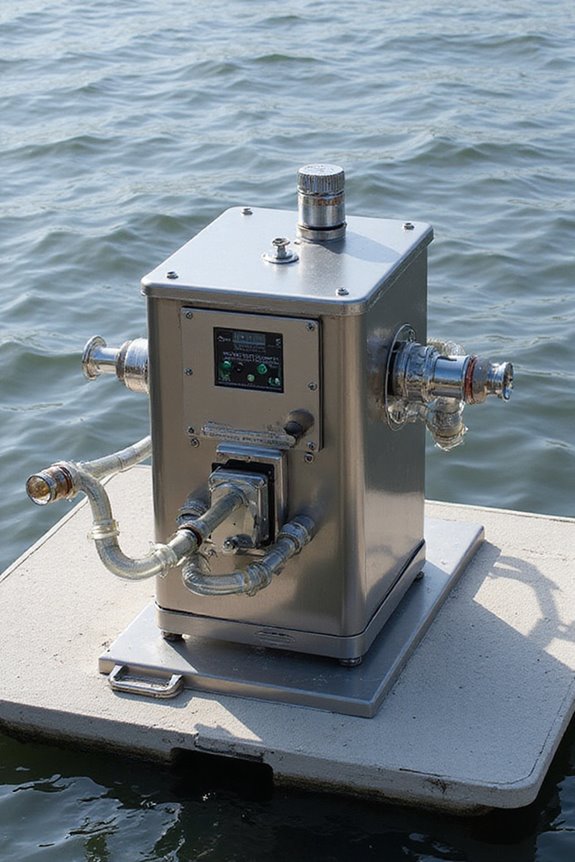
Although pump-out stations might seem like simple fixtures at marinas, they rely on a surprisingly complex web of funding and community support to keep running smoothly. Ever wonder who foots the bill? Well, grant eligibility plays a big role—federal programs like the Clean Vessel Act often provide matching funds, but you need that 25% local match to qualify. Community involvement is just as important; local organizations, marina owners, and even tribal governments pitch in, ensuring stations get built and stay operational. We love seeing volunteers and education campaigns boosting awareness, too—it’s a team effort! Grants usually cover everything from equipment upgrades to maintenance, but they come with rules, like capping pump-out fees. So, keeping these stations open isn’t just about infrastructure—it’s about us all pitching in.
Using Technology to Locate Pump-Out Station Facilities
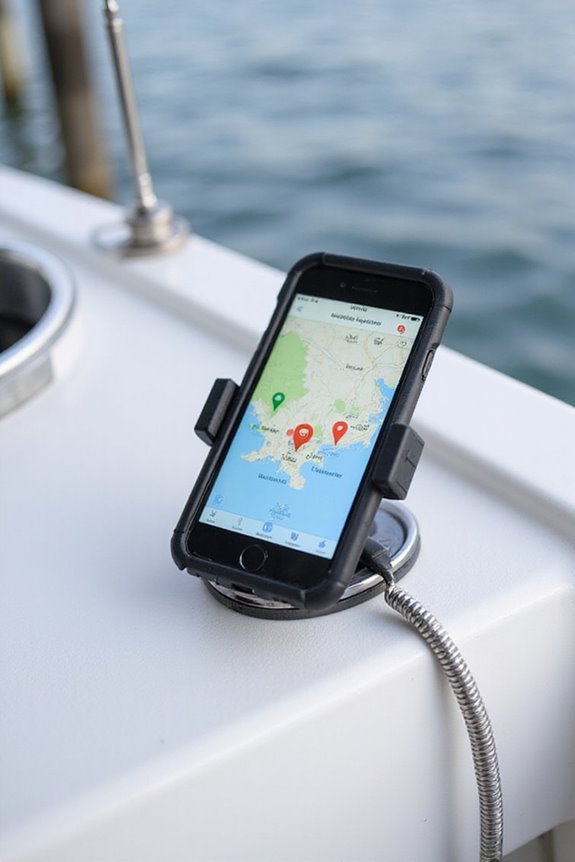
How do you find a pump-out station when you’re out on the water and your boat’s holding tank is full? Luckily, technology’s got our backs with apps like Pumpout Nav, loaded with handy app features that show nearby facilities on a clear, user-friendly map or list. You can tap or click to see hours, pricing, and even if the station’s working—no more guessing or detours! The app’s interface is designed for quick navigation, making it feel like a trusted mate guiding you to the nearest dump station or floating restroom. Plus, real-time monitoring systems alert marinas and boaters about any issues, keeping everything running smooth. So, next time you’re cruising, why not let these smart tools save you time and headaches?
Environmental Benefits of Proper Sewage Disposal on Waterways
When we think about keeping our waterways clean, proper sewage disposal on boats might not be the first thing that comes to mind—but it should be. By using pump-out stations, we help with nutrient reduction, curbing those pesky algal blooms that can turn clear water into a green soup. This careful handling isn’t just about looks—it’s about aquatic protection, shielding fragile habitats like coral reefs and seagrasses from harmful pollutants. Plus, maintaining water quality benefits all of us who enjoy boating, fishing, or simply soaking in nature’s beauty. So, next time you prep your boat, remember: disposing of sewage properly isn’t just good manners, it’s a crucial step that keeps our waterways healthy and thriving for everyone’s enjoyment. After all, who wants to swim in a floating soup?
How Mobile Apps Enhance Boater Access to Waste Facilities
Ever wondered how technology can make your next pumpout stop a breeze? Mobile apps designed for boaters radically improve our user experience by tapping into real time updates and GPS. Instead of guessing where to go, we get instant maps showing the nearest pumpout stations or floating restrooms—no more awkward circuits around marinas. These apps refresh as we move, offering up-to-the-minute info on facility status, hours, and even costs. Plus, they let us save favorite spots and track past visits, making planning future trips easier. Facing a broken pumpout? Just report it through the app, helping keep facilities in shape for everyone. So really, using these tools transforms waste disposal from a hassle into something almost… dare I say, seamless? Now that’s tech sailing smoothly with us.
Best Practices for Maintaining Water Quality and Ecosystem Health
Finding our way to pump-out stations with apps is great, but keeping the water safe and healthy is the real win for everyone on the water. We all want cleaner water, right? Using well-maintained, accessible pump-out stations prevents harmful sewage discharge that would otherwise jeopardize water quality and harm ecosystem health. Plus, when we regularly use and care for these facilities, we reduce nutrient overload—meaning less algae choking our waters and more oxygen for fish and plants. What’s better than knowing our actions support vibrant aquatic life? Remember, poor waste management fuels pollution risks and weakens marshy habitats, so let’s commit to educating fellow boaters and practicing good habits. After all, protecting these waters guarantees they stay inviting and alive for all of us aboard today—and tomorrow.
Frequently Asked Questions
How Much Does It Cost to Use a Boat Pump-Out Station?
It is understood “you get what you pay for.” Pump out fees vary by tank size and location, often paid by card or cash. Let’s navigate these costs together, ensuring smooth, environmentally friendly boating experiences for all of us.
Are Pump-Out Services Available 24/7 at All Marinas?
We’ve found that availability hours for pump-out services vary widely; not all marinas provide 24/7 marina services. Let’s stay connected and check each location’s posted hours to guarantee we’re covered when we need it most.
Can Non-Motorized Boats Use Pump-Out Stations?
We wish non-motorized boats could magically use pump-out stations like their motorized cousins, but pump out regulations and non motorized requirements just don’t allow it. Let’s stick together and embrace proper disposal methods instead.
What Should I Do if a Pump-Out Station Is Out of Order?
If a pump-out station’s out of order, let’s report it right away and seek alternative options like nearby stations or portable services. We’ll also prepare emergency procedures, ensuring we comply with regulations and protect our boating community.
How Long Does the Pump-Out Process Typically Take?
Together, we navigate the pump-out process like the steady pulse of a tide—usually 5 to 15 minutes. Embracing time efficiency, we share this routine, knowing every moment brings us closer as a community on the water.

